The Hype and Reality of E-ink Technology
E-ink technology, a fascinating innovation that's become the cornerstone of e-readers like the Kindle and the Nook, continues to evolve and expand its applications. This article delves into the intricacies of E-ink, tracing its history, current trends, and speculative future.

Before we dive into the current state of E-ink technology, let’s rewind to where it all started. The concept of electronic paper was first developed in the 1970s at Xerox’s Palo Alto Research Center. The idea was to create a display that could mimic the appearance of regular ink on paper. Fast forward to 1997, E Ink Corporation was founded and they developed the first commercial E-ink product in 2000. This new technology was a game changer, providing a digital platform that was easy on the eyes and required minimal power.
E-ink Today: Beyond E-readers
E-ink technology has come a long way from its initial application in e-readers. Today, it’s finding its place in a variety of devices - from smartwatches to digital signage, and even in smartphones. The YotaPhone, for instance, has an E-ink display on its back, while the FES Watch U, a smartwatch from Sony, uses E-ink for both its face and band.
The Advantages and Challenges of E-ink
E-ink displays offer several advantages over traditional LCD or OLED screens. They’re more power-efficient, easier to read in direct sunlight, and more comfortable for extended reading sessions. However, they also face significant challenges. E-ink screens have a slower refresh rate, which makes them less suitable for tasks like video playback or fast-paced gaming. Moreover, color E-ink displays, while technically possible, are still not as vibrant as their LCD or OLED counterparts.
The Estimated Market Impact
The global E-ink display market was valued at approximately $2.26 billion in 2020 and is expected to reach around $3.89 billion by 2026, growing at a compound annual growth rate (CAGR) of 9.5% during the forecast period. This growth is driven by the increasing adoption of E-ink displays in various devices, including e-readers, smartwatches, and digital signage.
The Future of E-ink
The future of E-ink technology is intriguing. Researchers are continually exploring ways to improve the color rendering and refresh rate of E-ink screens. In addition, the possibility of incorporating E-ink displays into flexible or even foldable devices holds great potential. Imagine a foldable e-reader that you can tuck into your back pocket or a digital newspaper that rolls up like its print counterpart.
In conclusion, E-ink technology, while not without its challenges, holds immense potential. Its unique advantages make it a strong contender in the display market, and ongoing research promises to push the boundaries of what’s possible with E-ink. It’s an exciting time for this technology, and we can’t wait to see where it goes next.




